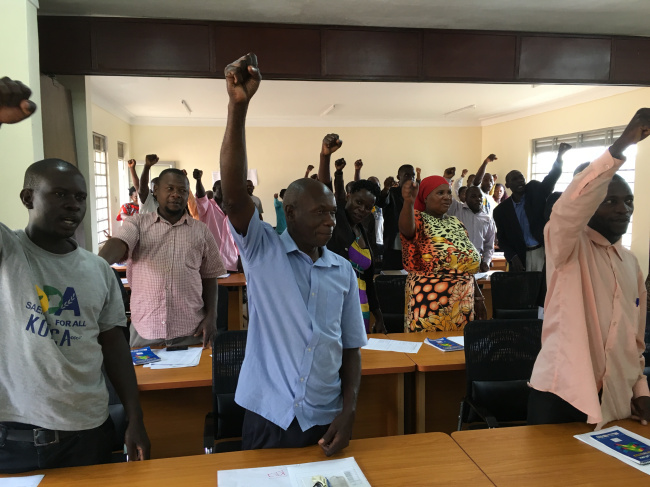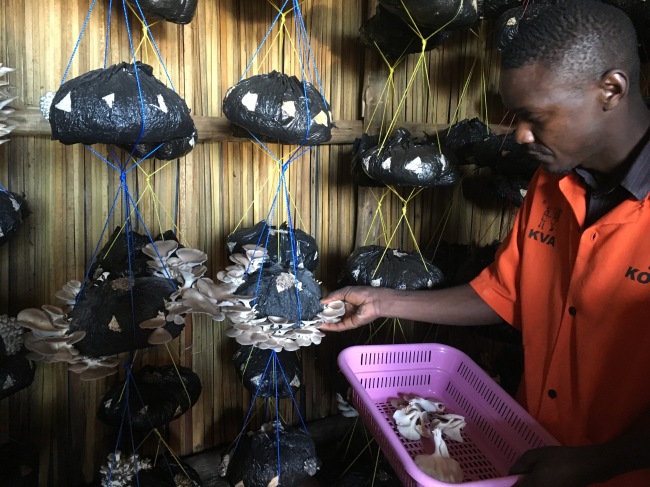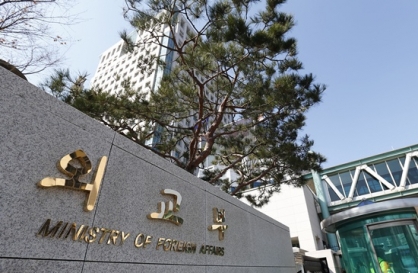Korea boosts community-driven rural development in Uganda
By Shin Hyon-heePublished : May 11, 2016 - 16:40
KAMPALA/MPIGI/MUGONGO, UGANDA -- “I work first! I serve first! I sacrifice first!”
About 35 community leaders of this rural district of Mpigi stood up, clenched their fists and chanted this slogan after mapping out challenges faced by their villages and detailing action plans to tackle them.
The leaders, some as young as 25 and up to 70 years old, were handpicked by their own people to spearhead rural development, taking a page from the Saemaul (new village) movement that unfolded in the 1970s in Korea.
About 35 community leaders of this rural district of Mpigi stood up, clenched their fists and chanted this slogan after mapping out challenges faced by their villages and detailing action plans to tackle them.
The leaders, some as young as 25 and up to 70 years old, were handpicked by their own people to spearhead rural development, taking a page from the Saemaul (new village) movement that unfolded in the 1970s in Korea.

James Kitimba, a 30-year-old secretary who represents the village of Nsamu, listed a lack of water and electricity, low agricultural output, poor sanitation and ill-equipped schools as some of the pressing issues in his area. To address the problems, he examined the causes and then laid out possible solutions. For instance, joint funding to distribute hybrid cattle, household contributions of labor, bricks, timber and other materials, and training on water harvesting.
“We have to walk long distances to get water, and because there are no toilets, we resort to bushes which run off in rainy seasons and thus make the water not safe,” Kitimba said.
“As a community, we can dig tanks, for which we need to bring bricks, sand and cement, provide labor, and get technical support. We can also build small farms on a sharing basis. Then we’re good to go.”
The session on April 29 capped a weeklong training session at the National Farmers Leadership Center built by the Korea International Cooperation Agency in Kampiringisa, some 53 kilometers southwest of the capital Kampala.
Throughout the period, the participants also received education on Saemaul spirits, agricultural and livestock techniques and farm management, community governance and leadership, microfinance, and gender equality, among others.
The activities are intended to jack up household incomes while laying the foundation for strengthening the community’s productive capacity and improving living conditions, KOICA officials said.
During Kitimba’s presentation, some participants took notes, nodding their heads, while others asked questions and gave advice based on their own situations. Despite the packed schedule that started with exercise at 5 a.m., they appeared feisty and determined, cheering each other and singing together the traditional song “Mwoto wawaka,” which means fire at work.
The upbeat atmosphere illustrates the gist of the Saemaul movement, which puts priority on nurturing a sense of ownership and can-do spirit, based on the principles of diligence, burden-sharing and self-reliance, according to the organizers. It also shows a revival of Uganda’s own “bulungi bwansi (community work)” campaign from the 1960s.
“We’re trying to address the rural communities’ dependence on the government, changing our mindset from the past,” said John Mary Luwakanya, a council chairman of the Mpigi district.
“The core issue is self-help -- how to come forward to assist one another. Look at the Saemaul movement and Korea, people didn’t sit and wait. We also want to move along.”
With seven model villages, Mpigi has been at the vanguard of the drive since the inception of the training center in 2011 upon Uganda’s request a year earlier.
Ugandan Yoweri Museveni also expressed interest in the Saemaul campaign during his summit with President Park Geun-hye in Seoul in May 2013, as he is carrying out his National Development Plan aimed at eradicating poverty through economic growth.
Agriculture remains the mainstay of the East African country’s economy, involving around 73 percent of the labor force as of 2005 and making up nearly 24 percent of its gross domestic product in 2009. But agricultural growth has slowed in recent years to a mere 2.6 percent in 2009 from 7.9 percent in 2001, far below the African Union’s 6 percent target.
To help shore up Uganda’s development, KOICA is carrying out 19 projects on rural reform, education and health, either on its own or in partnership with local and international nongovernmental organizations. It also dispatches 24 volunteers throughout the nation.
A total of 587 officials of the central and local governments have been trained in Korea until the end of last year.
Uganda’s zeal for Korean development was highlighted during a competition hosted for the first time by the Korean Embassy in April last year, in which some 190 villages took part by submitting their respective Saemaul ideas and action plans. Fifteen communities were ultimately selected, winning prizes ranging from an iron roof for a community hall to mowing machines and crop seeds.
“It was a six-month race during which KOICA visited all the villages to see how the plans were implemented and the people were really passionate,” said Korean Ambassador to Uganda Park Jong-dae, adding that the mission is currently taking applications for a second round competition.
“I think through the Saemaul model, they are looking to curb their reliance on state support and revive what they had before, self-reliance and self-activities that formed the backbone of ‘bulungi bwansi.’”
“We have to walk long distances to get water, and because there are no toilets, we resort to bushes which run off in rainy seasons and thus make the water not safe,” Kitimba said.
“As a community, we can dig tanks, for which we need to bring bricks, sand and cement, provide labor, and get technical support. We can also build small farms on a sharing basis. Then we’re good to go.”
The session on April 29 capped a weeklong training session at the National Farmers Leadership Center built by the Korea International Cooperation Agency in Kampiringisa, some 53 kilometers southwest of the capital Kampala.
Throughout the period, the participants also received education on Saemaul spirits, agricultural and livestock techniques and farm management, community governance and leadership, microfinance, and gender equality, among others.
The activities are intended to jack up household incomes while laying the foundation for strengthening the community’s productive capacity and improving living conditions, KOICA officials said.
During Kitimba’s presentation, some participants took notes, nodding their heads, while others asked questions and gave advice based on their own situations. Despite the packed schedule that started with exercise at 5 a.m., they appeared feisty and determined, cheering each other and singing together the traditional song “Mwoto wawaka,” which means fire at work.
The upbeat atmosphere illustrates the gist of the Saemaul movement, which puts priority on nurturing a sense of ownership and can-do spirit, based on the principles of diligence, burden-sharing and self-reliance, according to the organizers. It also shows a revival of Uganda’s own “bulungi bwansi (community work)” campaign from the 1960s.
“We’re trying to address the rural communities’ dependence on the government, changing our mindset from the past,” said John Mary Luwakanya, a council chairman of the Mpigi district.
“The core issue is self-help -- how to come forward to assist one another. Look at the Saemaul movement and Korea, people didn’t sit and wait. We also want to move along.”
With seven model villages, Mpigi has been at the vanguard of the drive since the inception of the training center in 2011 upon Uganda’s request a year earlier.
Ugandan Yoweri Museveni also expressed interest in the Saemaul campaign during his summit with President Park Geun-hye in Seoul in May 2013, as he is carrying out his National Development Plan aimed at eradicating poverty through economic growth.
Agriculture remains the mainstay of the East African country’s economy, involving around 73 percent of the labor force as of 2005 and making up nearly 24 percent of its gross domestic product in 2009. But agricultural growth has slowed in recent years to a mere 2.6 percent in 2009 from 7.9 percent in 2001, far below the African Union’s 6 percent target.
To help shore up Uganda’s development, KOICA is carrying out 19 projects on rural reform, education and health, either on its own or in partnership with local and international nongovernmental organizations. It also dispatches 24 volunteers throughout the nation.
A total of 587 officials of the central and local governments have been trained in Korea until the end of last year.
Uganda’s zeal for Korean development was highlighted during a competition hosted for the first time by the Korean Embassy in April last year, in which some 190 villages took part by submitting their respective Saemaul ideas and action plans. Fifteen communities were ultimately selected, winning prizes ranging from an iron roof for a community hall to mowing machines and crop seeds.
“It was a six-month race during which KOICA visited all the villages to see how the plans were implemented and the people were really passionate,” said Korean Ambassador to Uganda Park Jong-dae, adding that the mission is currently taking applications for a second round competition.
“I think through the Saemaul model, they are looking to curb their reliance on state support and revive what they had before, self-reliance and self-activities that formed the backbone of ‘bulungi bwansi.’”

In Mugongo, some 120 kilometers north of Kampala, KOICA volunteer Kim Young-joo has been spurring a mushroom boom among farming households, earning for herself the nickname “Queen of mushrooms.”
The 40-year-old certified mushroom seeds craftsman arrived in the town of around 10,000 in May 2014 with the goal of spreading oyster mushroom cultivation skills and establishing a distribution system.
Mushroom appeared a promising source of income there given its handsome market prices and constant demand from local restaurants and households for traditional Ugandan dishes like luwombo, food steamed in banana leaves, Kim said. The crop also requires relatively less space and initial facility investment. It also takes a shorter time to reap.
After five rounds of failure, she succeeded in incubation and harvesting last October, and provided related education and practice to the villagers for two months in collaboration with Makerere University in Kampala. The farmers, who have now mastered the techniques and created a growers and suppliers guild, began supplying the yields in the market in January.
“When I first came, they needed something that could instantly generate income. Most of the people here lived by breeding livestock, which was not my area, and then I found one mushroom grower in the village,” Kim said.
“In the past, restaurants did have mushroom dishes on their menus but could not sell because of supply shortages. Now we’re focusing on promoting our products at local marketplaces.”
One kilogram of oyster mushrooms takes one month to harvest, and sells for up to 7,000 Ugandan shilling ($2.10), according to Kityo Joseph, chair of Mugongo. In comparison, beans and maze need three to four months and can fetch only 2,000 shilling and 500 shilling, respectively.
“This type of product is economically valuable because prices are high,” the 52-year-old senior villager said as he and other farmers demonstrated the cultivation process to visiting Korean reporters at a model farm.
“Thanks to Korea, we can now grow mushrooms with not much space and not much money.”
By Shin Hyon-hee (heeshin@heraldcorp.com)
Korea Herald Correspondent




![[Weekender] Korean psyche untangled: Musok](http://res.heraldm.com/phpwas/restmb_idxmake.php?idx=644&simg=/content/image/2024/05/02/20240502050841_0.jpg&u=)

![[Eye Interview] 'If you live to 100, you might as well be happy,' says 88-year-old bestselling essayist](http://res.heraldm.com/phpwas/restmb_idxmake.php?idx=644&simg=/content/image/2024/05/03/20240503050674_0.jpg&u=)










![[Herald Interview] Director of 'Goodbye Earth' aimed to ask how we would face apocalypse](http://res.heraldm.com/phpwas/restmb_idxmake.php?idx=652&simg=/content/image/2024/05/03/20240503050732_0.jpg&u=)
